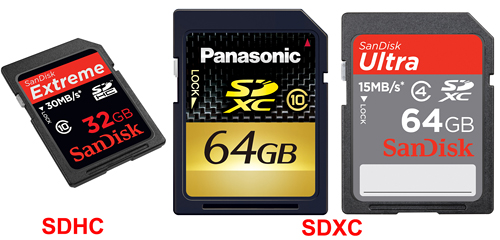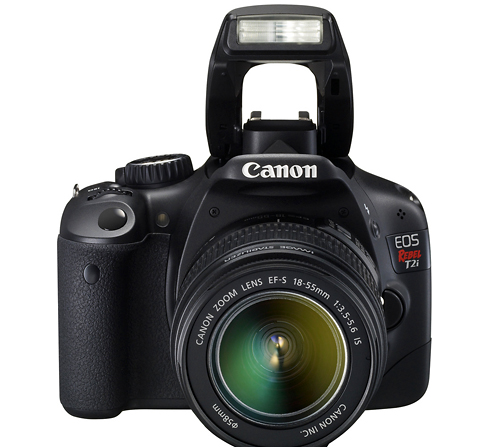Question
I read a blurb on the Internet about the new Class 10 SDXC cards in several brands. This type of memory card sounds perfect: super fast and tons of capacity at 64 gigabytes. Why would anyone want to use any other kind of SD card, except for the high price of the SDXC card? G.R.
Answer
That was certainly interesting news, and the first Extended Capacity cards will be available sometime this spring: Panasonic’s Gold SDXC and SanDisk’s Ultra SDXC. (Other brands, in various speed classes will follow.)
Do note, however, that the Panasonic cards boast a Class 10 speed rating while the SanDisk SDXC cards are Class 4 rated, or not as fast. The SanDisk 64GB card is less expensive however, approximately $350 versus $600 for the Panasonic product.

Initially, SanDisk will primarily target owners of video camcorders with their SDXC card. Class 4 speed is all that’s required with most such cameras. Panasonic’s Class 10 SDXC product – like SanDisk’s conventional super fast Extreme SDHC Class 10 card – is more suitable for owners of high resolution DSLRs. It will allow for taking a greater number of shots in a very long sequence and the camera will be ready for more quite quickly afterward. Class 10 speed is fine for shooting video too, more than adequate even for the 1080p at 30 frames per second that’s possible with some DSLRs.
A 64 GB card may seem attractive since it will hold thousands of still images or over 60 hours of video. That may be necessary for some pros but you may not want to “put all your eggs in one basket”, so to speak. (And frankly, even SDHC cards are available in 32 GB capacity.)
If you were to lose a 64 GB card – or if it became corrupted – think of the number of images or the video clips that you would never get to use. That’s why it makes more sense to buy several 8 GB cards instead, to get all the capacity you need.

More importantly, there’s the compatibility issue. An SDXC card looks identical to an SDHC card but it’s formatted to work only with SDXC-compliant cameras. At this time, that includes only the Canon and Panasonic digicams and camcorders announced since Jan. 1, 2010 and the Canon EOS T2i (EOS 550D in some countries).
Eventually we’ll see a lot more SDXC-compliant equipment. But for the near future, SDHC will remain the card of choice for the vast majority of photo enthusiasts. (Of course some cameras use one of the other formats: CompactFlash or Memory Stick both available in high capacity versions.)
Derek
27 Jun 2010Wow, interesting news. Can’t wait to slap one of these babies in my DSLR
James
25 Sep 2010I stick to 4GB cards. That enables me to get 200-300 10MP RAW images on each card. I have 4 cards – 16GB – about 1000 images. The main advantages of going no higher than 4GB are.
1) I can copy a whole 4GB card onto a DVD and post it home if I am travelling, giving that extra level of backup.
2) A 4GB card has a reasonable download time ). A decent speed card will take less than 5 minutes). A 64GB card of same speed rating could take close to 1.5 hours. Even a high speed rated card could take in excess of 1/2 hour.
3) If I lost, damaged or accidentally formatted a 32GB or 64GB card while travelling that would be 4000+ images lost in one fowl swoop – eek! Also a lot of money to replace it compared a cheap 4GB card.
4) My Digimate battery powered hard drive/card reader can transfer about 8-12GB to its HDD on one battery charge. If I had a 64GB card (even a 16 or 32GB card) I would not be able to download it to my digimate. Sure I would not need to for capacity – but there is no backup unless I do a transfer.
5) You are tempted to not download for days/weeks – which just is not sensible. For a start I like to see the photos I took that day. Otherwise there is the massively long session to download 1000’s of images sort, name, group, keyword, adjust, post to flickr etc etc – it will seem like an unmanageable chore. And what happens if you realise you shot a whole session at a really spot at -2EV. I did this once on a bright sunny day, so I was not looking at my screen much. When I downloaded that evening and realised my mistake I was able to pop back to reshoot the next day (I even scored some better light so maybe it was fate). But if I had 64GB and probably completed another few days travel there would have been no going back.
Now for the big PRO
If you shoot video then 32 or 64GB is going to be awesome. But man you will need a big HDD to store those files!
So
If you are shooting at anything less than maximum resolution for fear of running out of card space – for goodness sake buy a bigger card! Always capture at the BEST resolution possible. You can always resize or crop down, but never up. But don’t buy a bigger card than you need, better still buy a 2 cards of a size that enables you to effectively manage your images rather than putting all your photos of eggs into one basket.